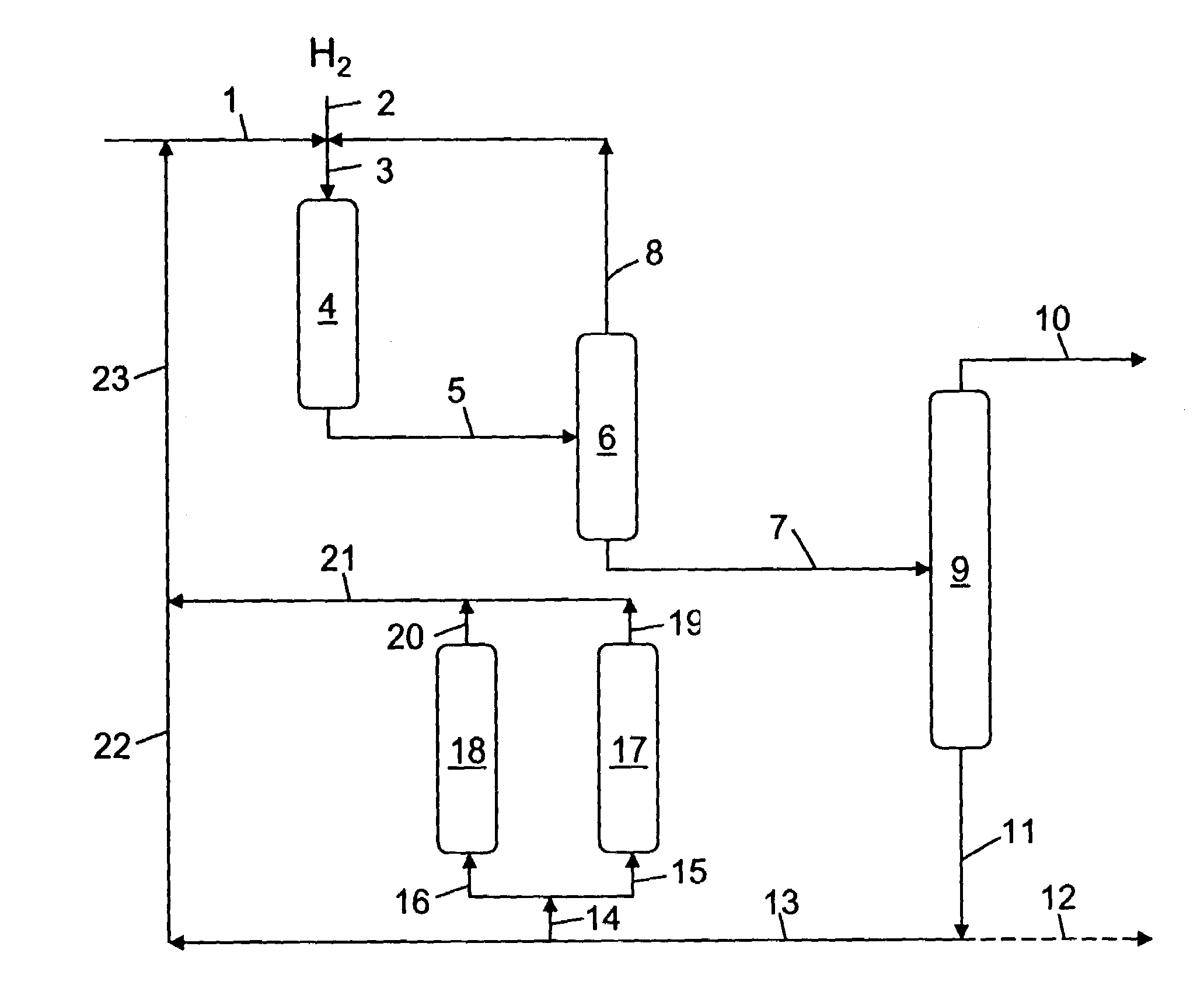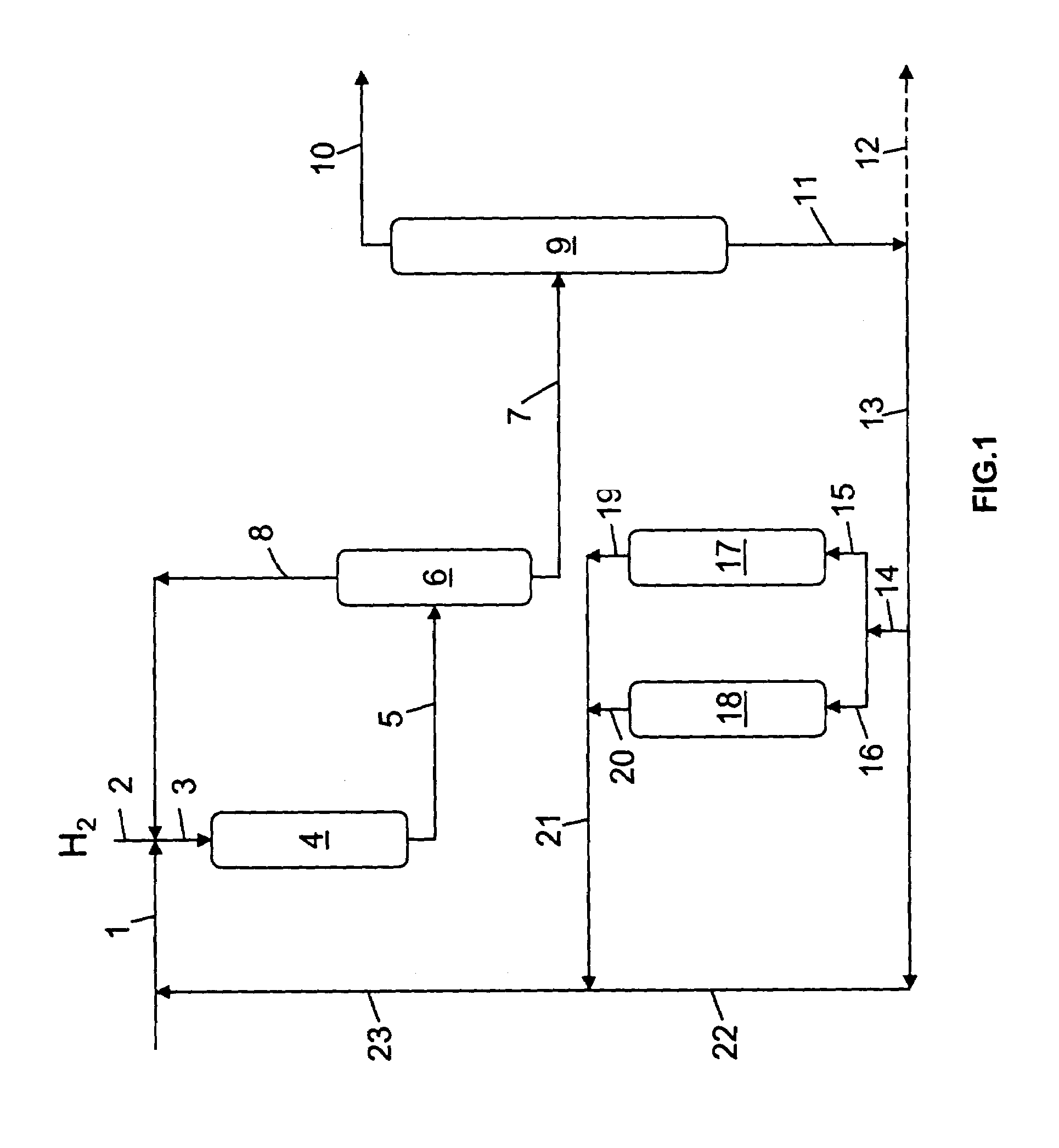Hydrocracking process with recycle, comprising adsorption of polyaromatic compounds from the recycled fraction on an adsorbant based on silica-alumina with a limited macropore content
a technology of hydrocracking and recycle, applied in the field of hydrocracking processes, can solve the problems of loss of capacity, accumulation of polyaromatic compounds (pna), and low yield
- Summary
- Abstract
- Description
- Claims
- Application Information
AI Technical Summary
Benefits of technology
Problems solved by technology
Method used
Image
Examples
example 1
Preparation of Silica Alumina SA1
[0125]Adsorbent SA1 was obtained as follows.
[0126]Alumina-silica gels were prepared by mixing sodium silicate with water and passing this mixture over an ion exchange resin. A solution of aluminium chloride hexahydrate in water was added to the decationized silica sol. To obtain a gel, ammonia was added, the precipitate obtained was filtered and washing was carried out with a solution of water and concentrated ammonia until the conductivity of the washing water was a constant. The gel from this step was mixed with Pural boehmite powder so that the final composition of the mixed support as the anhydrous product was, at this stage of the synthesis, 70% Al2O3-30% SiO2. This suspension was fed into a colloidal mill in the presence of nitric acid. The amount of nitric acid added was adjusted so that the percentage of nitric acid at the outlet from the mill was 8% with respect to the mass of solid mixed oxide. This mixture was then filtered to reduce the q...
example 2
Comparison of Elimination of PNAs from a Feed by Adsorption on Porous Solid
[0146]The feed used corresponded to residues from the bottom of a fractionation column. Its pour point was of the order of 36° C. and its density at 15° C. was 0.8357. It contained 95% by weight of saturated compounds (83.6% by weight of paraffinic compounds and 11.4% by weight of naphthenic compounds), 0.5% by weight of resins and 2.9% by weight of aromatic compounds, 2.6% by weight of which was constituted by monoaromatic compounds, 0.56% by weight of which was constituted by diaromatic compounds, 0.57% by weight of which was constituted by triaromatic compounds, 2704 ppm of pyrene (4 rings), 1215 ppm of perylene (5 rings) and 59 ppm of coronene (7 rings).
[0147]The porous solids tested corresponded to a mesoporous solid of the purely silicic MCM-41 type, a SiO2 bridged beidellite type clay, a silica gel, an activated alumina, a physically activated charcoal from a cellulose precursor and a silica-alumina of...
example 3
Regeneration of Adsorbent by Burning
[0155]The adsorbent was regenerated by burning using a stream of N2 containing 5% of O2 at 550° C. After these operations, 97% of the capacity of the starting solid was recovered.
[0156]This operation could be carried out about ten times before losing 30% of capacity.
PUM
| Property | Measurement | Unit |
|---|---|---|
| BET specific surface area | aaaaa | aaaaa |
| packing density | aaaaa | aaaaa |
| temperature | aaaaa | aaaaa |
Abstract
Description
Claims
Application Information
 Login to view more
Login to view more - R&D Engineer
- R&D Manager
- IP Professional
- Industry Leading Data Capabilities
- Powerful AI technology
- Patent DNA Extraction
Browse by: Latest US Patents, China's latest patents, Technical Efficacy Thesaurus, Application Domain, Technology Topic.
© 2024 PatSnap. All rights reserved.Legal|Privacy policy|Modern Slavery Act Transparency Statement|Sitemap



